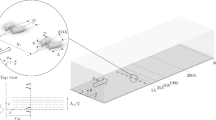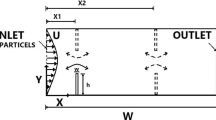Abstract
In the present paper, a laminar cavity is analysed at very low Mach numbers. The characteristics of core-vortices are proposed and commented. The experiments were performed in an open subsonic wind tunnel using particle image velocimetry (PIV). A rectangular cavity with a length-to-depth ratio of 4 was used (shallow and open type). Three different Reynolds numbers, based on cavity depth and free stream velocity, were examined (Re h =4,000, 9,000 and 13,000). The upstream boundary layer was investigated using classical hot-wire anemometry and was found to be laminar. For each Reynolds number, a total of 1,000 vectors fields were acquired. The results are given in terms of conventional quantities (mean flow velocity, turbulence characteristics, Reynolds shear stress) and also in terms of vortex characteristics (such as probability density function of vortex location, vortex size and vortex circulation). Some of these vortex characteristics are then proposed in a local averaged presentation. The extraction of vortices from instantaneous flow fields has been done through the use of a home-made algorithm based on continuous wavelet analysis.






















Similar content being viewed by others
References
Farge M (1992) Wavelet transforms and their applications to turbulence. Ann Rev Fluid Mech 24:395–457
Gharib M, Roshko A (1987) The effect of flow oscillations on cavity drag. J Fluid Mech 177:501–530
Ho CM, Huerre P (1984) Perturbed free shear layers. Ann Rev Fluid Mech 16:365–424
Howe MS (1997) Edge, cavity, and aperture tones at very low Mach numbers. J Fluid Mech 330:61–84
Jeong J, Hussain F (1995) On the identification of a vortex. J Fluid Mech 285:69–94
Karamcheti K (1955) Sound radiation from rectangular cutouts. NACA TN 3488
Komerath NM, Ahuja KK, Chambers FW (1987) Prediction and measurement of flows over cavities—a survey. In: Proceedings of the AIAA 25th aerospace sciences meeting, Reno, Nevada, January 1987
Larchevêque L, Sagaut P, Mary I, Labbé O, Comte P (2003) Large-eddy simulation of a compressible flow past a deep cavity. Phys Fluids 15(1):193–210
Lin JC, Rockwell D (2001) Organized oscillations of initially turbulent flow past a cavity. AIAA J 39(6):1139–1151
Raffel M, Willert C, Kompenhans J (1998) Particle image velocimetry: a practical guide. Springer, Berlin Heidelberg New York
Rockwell D, Naudascher E (1978) Review—self-sustaining oscillations of flow past cavities. J Fluid Eng 100:152–165
Sarohia V (1977) Experimental investigation of oscillations in flows over shallow cavities. AIAA J 15(7):984–991
Scarano F (2002) Iterative image deformation methods in PIV. Meas Sci Technol 13(1):R1–R19
Scarano F, Riethmuller ML (1999) Iterative multigrid approach in PIV image processing with discrete window offset. Exp Fluids 26:513–523
Scarano F, Riethmuller ML (2000) Advances in iterative multigrid PIV image processing. Exp Fluids 29:S51–S60
Schlichting H (1968) Boundary layer theory, 6th edn. McGraw-Hill, New York, p 129
Schram C, Rambaud P, Riethmuller ML (2004) Wavelet based eddy structure eduction from a backward facing step flow investigated using particle image velocimetry. Exp Fluids 36:233–245, DOI 10.1007/s00348-003-0695-9
Shankar PN, Deshpande MD (2000) Fluid mechanics in the driven cavity. Ann Rev Fluid Mech 32:93–136
Sinha SN, Gupta AK, Oberai MM (1982) Laminar separating flow over backsteps and cavities. Part II: cavities. AIAA J 20(3):370–375
Stuart JT (1967) On finite amplitude oscillation in laminar mixing layers. J Fluid Mech 29(3):417–440
Tam CKW, Block PJW (1978) On the tones and pressure oscillations induced by flow over rectangular cavities. J Fluid Mech 89(2):373–399
Tang YP, Rockwell D (1983) Instantaneous pressure fields at a corner associated with vortex impingement. J Fluid Mech 126:187–204
Westerweel J (1998) Effect of sensor geometry on the performance of PIV interrogation. In: Proceedings of the 9th international symposium on applications of laser techniques to fluid mechanics, Lisbon, Portugal, July 1998
Ziada S, Rockwell D (1982) Vortex-leading edge interaction. J Fluid Mech 118:79–107
Ziada S, Rockwell D (1982) Oscillations of an unstable mixing layer impinging upon an edge. J Fluid Mech 124:307–334
Author information
Authors and Affiliations
Corresponding author
Rights and permissions
About this article
Cite this article
Özsoy, E., Rambaud, P., Stitou, A. et al. Vortex characteristics in laminar cavity flow at very low Mach number. Exp Fluids 38, 133–145 (2005). https://doi.org/10.1007/s00348-004-0845-8
Received:
Accepted:
Published:
Issue Date:
DOI: https://doi.org/10.1007/s00348-004-0845-8




